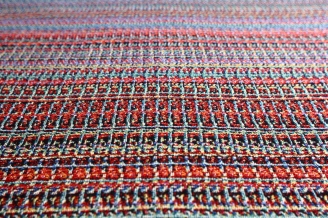Here is some sources to feed the concept project for my Wearable Electronics II project, which pursuits to create a sound generator with wearable technologies.
Computer generative patterns in embroideries.
- PCBs and functional schematics of alarms
As sound interfaces is considered to have an arrangement of oscillators Synthesizers embeded into textile fabric by hand or machine.
Soft electronics pulp based computing
The output of sound can be supported into a series of paper speakers for individual sound sources.
This array of speakers can create a sound spatialization by using light materials that facilitate his attachment to walls or suspension from the ceiling, in different parts of the room.

… these paper and fabric speakers are made by running 5-9V amplified sound signal through a very conductive coil in close proximity to a magnet. Unlike most speakers that have the wire coil wrapped cylindrically and placed around the magnet, here the coil is in the plane and directly adhered to the membrane that moves the air creating sound.

Large Multi-Hexagram Speaker
The same parallel/serial structure used to produce the smaller hexagram speaker at the top of this page can also be multiplied to make larger speakers. The more hexagram parallel structures (with magnets attached), the greater the potential volume output. This sheet (12” x 17” approx) is enough to drive a very robust signal.
From here i found interesting to experiment by creating different variations of speakers with different size of paper or spiral shapes.
About how to create custom tweeters, full range or subwoofer kind of speakers based on this tools?
Meanwhile here is a flat coil calculator.


